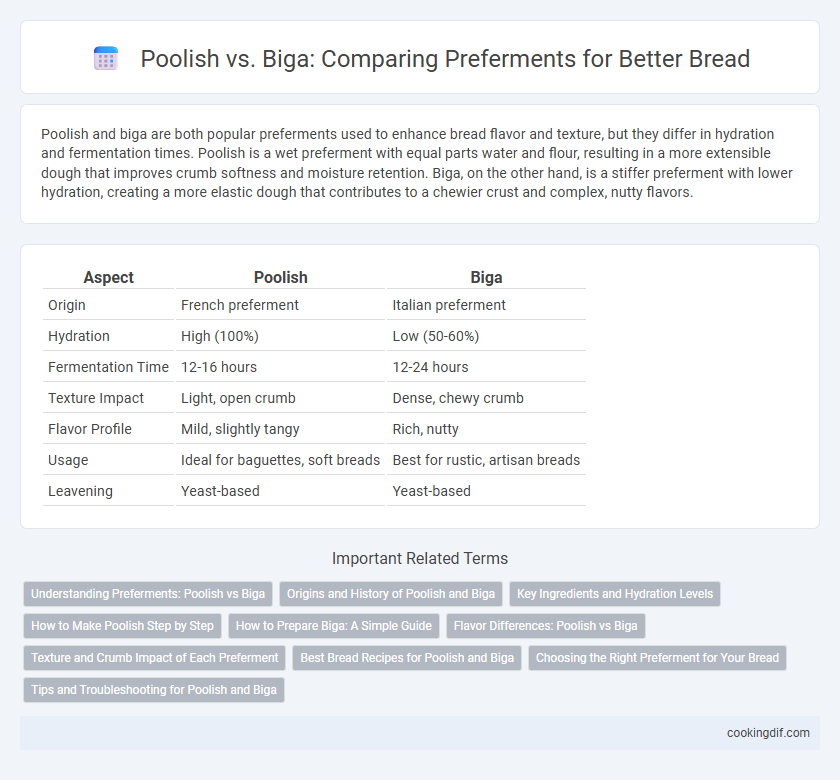Poolish and biga are both popular preferments used to enhance bread flavor and texture, but they differ in hydration and fermentation times. Poolish is a wet preferment with equal parts water and flour, resulting in a more extensible dough that improves crumb softness and moisture retention. Biga, on the other hand, is a stiffer preferment with lower hydration, creating a more elastic dough that contributes to a chewier crust and complex, nutty flavors.
Table of Comparison
| Aspect | Poolish | Biga |
|---|---|---|
| Origin | French preferment | Italian preferment |
| Hydration | High (100%) | Low (50-60%) |
| Fermentation Time | 12-16 hours | 12-24 hours |
| Texture Impact | Light, open crumb | Dense, chewy crumb |
| Flavor Profile | Mild, slightly tangy | Rich, nutty |
| Usage | Ideal for baguettes, soft breads | Best for rustic, artisan breads |
| Leavening | Yeast-based | Yeast-based |
Understanding Preferments: Poolish vs Biga
Poolish and biga are two traditional Italian preferments used to enhance bread flavor and texture, each with distinct hydration levels and fermentation times. Poolish features a high hydration ratio (about 100%) with equal parts flour and water, resulting in a bubbly, pourable starter that produces a lighter crumb and tangy flavor. Biga, with lower hydration (around 50-60%), creates a stiffer dough that develops a chewy texture and complex aroma, making it ideal for rustic, artisan-style breads.
Origins and History of Poolish and Biga
Poolish, originating from Polish bakers in the 19th century, is a wet preferment used extensively in French baking to enhance flavor and texture. Biga, an Italian preferment dating back to early 20th-century Northern Italy, features a stiffer consistency and contributes a nutty flavor and chewy crumb to bread. Both methods reflect regional fermentation traditions that have influenced modern artisanal bread-making worldwide.
Key Ingredients and Hydration Levels
Poolish and biga are traditional preferments used in artisan bread baking, distinguished primarily by their hydration levels and ingredient ratios. Poolish features equal parts water and flour, typically 100% hydration, creating a batter-like consistency that enhances dough extensibility and flavor development. Biga, with a lower hydration level usually around 50-60%, forms a stiff dough that contributes to a denser crumb structure and improved texture in breads like ciabatta.
How to Make Poolish Step by Step
To make poolish, combine equal parts by weight of flour and water, typically 100 grams each, with a small amount of yeast, around 0.1% of the flour weight, in a mixing bowl. Stir the mixture thoroughly until smooth, cover loosely with plastic wrap, and allow it to ferment at room temperature for 12 to 16 hours until bubbly and doubled in size. This preferment enhances the bread's flavor and texture by providing a mild tang and improved crumb structure.
How to Prepare Biga: A Simple Guide
To prepare biga, combine 100 grams of flour with 60 grams of water and 1 gram of active dry yeast, mixing until just incorporated into a stiff dough. Allow the mixture to ferment at room temperature for 12 to 16 hours, developing a nutty flavor and improved gluten structure. Use the biga in bread dough recipes to enhance texture, aroma, and shelf life.
Flavor Differences: Poolish vs Biga
Poolish imparts a milder, slightly tangy flavor due to its higher hydration, which encourages lactic acid bacteria development, while Biga produces a more complex, nutty taste with a drier texture that limits acidity. The fermentation time for Poolish generally ranges between 12 to 16 hours, enhancing subtle fruity notes, whereas Biga's slower fermentation, often 16 to 24 hours, intensifies deeper, maltier flavors. Bakers choose Poolish for lighter, airy breads and Biga when seeking a rustic crumb with pronounced aromatic qualities.
Texture and Crumb Impact of Each Preferment
Poolish creates a lighter, airier crumb with a more open texture due to its higher hydration, promoting enzymatic activity and gluten development. Biga, with lower hydration, results in a denser crumb and chewier texture, contributing a subtle nutty flavor and improved crust firmness. Both preferments enhance bread flavor complexity but impact crumb structure distinctly--poolish yields softness and openness, while biga offers firmness and a tighter crumb.
Best Bread Recipes for Poolish and Biga
Poolish and biga are two popular preferments used to enhance bread flavor and texture, each with unique hydration and fermentation characteristics. Poolish, a wet, sponge-like preferment with equal parts flour and water, excels in producing open crumb and mildly tangy flavor, ideal for French baguettes and rustic loaves. Biga, a stiffer preferment with lower hydration, imparts a nutty aroma and chewy texture, making it perfect for traditional Italian breads like ciabatta and focaccia.
Choosing the Right Preferment for Your Bread
Poolish and biga are both popular preferments used to enhance bread flavor and texture, but they differ in hydration and fermentation time. Poolish is a wet, batter-like preferment with equal parts water and flour, ideal for creating open crumb structures and a mild, tangy taste. Biga, a stiffer preferment with lower hydration, produces denser crumb and stronger gluten development, making it suitable for traditional Italian breads like ciabatta.
Tips and Troubleshooting for Poolish and Biga
Poolish requires a higher hydration level, usually around 100%, making it more fluid and easier to mix, while biga is stiffer with hydration around 50-60%, which provides more structure and longer fermentation potential. To troubleshoot poolish, ensure consistent room temperature (around 70degF/21degC) to prevent overfermentation and maintain a bubbly, sponge-like texture ideal for aroma development. When working with biga, monitor its firmness and ferment it for 12-16 hours to avoid underdeveloped flavor or excessive acidity that can result from overfermentation.
Poolish vs Biga for preferments Infographic

 cookingdif.com
cookingdif.com